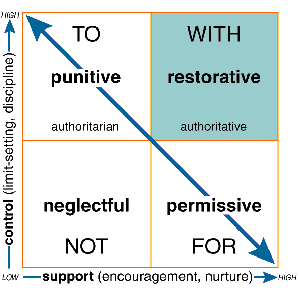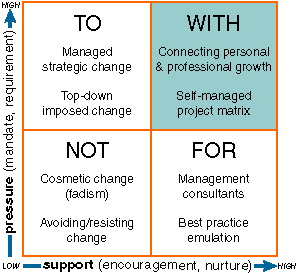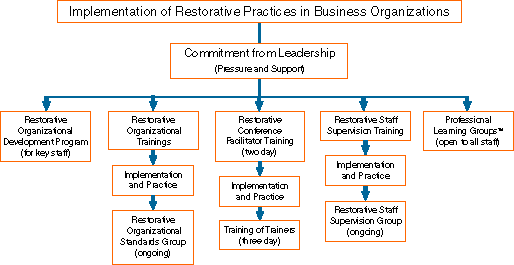In this paper Ted Wachtel, president of IIRP, discusses the application of restorative practices in business organizations.
Adapted from a paper presented at
the "Reshaping Australian Institutions Conference,"
The Australian National University, Canberra, February 16-18, 1999.
Restorative practices, conceived as an effective way of dealing with offenses in the criminal justice system and more recently with offenses in schools, has significant implications for the seemingly unrelated world of business. Besides helping to repair the harm caused by wrongdoing, mistakes and conflict, an unexpected result of restorative practices in business has proved to be an enhanced sense of community. In addition to protecting a company’s human capital from the competition, social bonds and improved relationships fostered by restorative practices within an organization create an environment that supports the learning and change demanded by the new knowledge economy.
Punitive-Permissive Continuum
Punishment in response to wrongdoing is the prevailing practice throughout modern society, not just in courts and schools, but in families and workplaces as well. Those who fail to punish naughty children and offending youths and adults are often labeled as "permissive."
Max Weber (1864-1930) first articulated the classic punitive approach to social discipline in business organizations. He assumed that people are basically lazy and untrustworthy. The purpose of discipline is to maintain order through clear lines of authority and rules, strictly enforced by a system of punishments and rewards (Souryal, 1995:42). Taylor (1947) advocated designing work "scientifically," in such a way that the human element has minimum influence on production. Both Weber and Taylor favored an authoritarian approach to organizational management.
Redeker (1989) describes the modern version of organizational authoritarianism as the "progressive" model of employee discipline–progressive because it involves a graduated series of punitive responses for minor misbehavior leading to summary dismissal without opportunity for redemption for theft, assault, intoxication or criminal offenses (Redeker, 1989:70, fn5).
McGregor (1960) studied worker productivity and postulated Theory X and Theory Y as opposites on a continuum. Theory X is the classical perception of humans, implying that management must constantly control, punish and manipulate the worker. Theory Y envisioned workers as willing to work and failing to be productive only when management failed to provide the proper motivators. Factors found to produce satisfaction in workers were the work itself, a friendly work atmosphere, personal recognition and acknowledgement of achievement, professional growth, work challenge, accomplishments, responsibility and discretion. Thus, from a human relations perspective, the essential task of management is to arrange conditions and operations optimally for the people who work for them. The latter approach, where the leader’s responsibility is to do things FOR employees, tends toward a "permissive" management style relative to the punitive style of management where the leader does things TO employees.
![]()
Figure 1: Punitive-Permissive Continuum
Social Discipline Window
This punitive-permissive continuum (Figure 1) reflects the current societal view, a very confined perspective with limited choice–to punish or not to punish. The only other variable is the severity of the punishment. However, we can construct a more useful view of social discipline by looking at the interplay of two more comprehensive variables, control and support (Figure 2) (Wachtel & McCold, 2000).

Figure 2: Social Discipline Window
We define "control" as discipline or limit-setting and "support" as encouragement or nurturing. Now we can combine a high or low level of control with a high or low level of support to identify four general approaches to social discipline: neglectful, permissive, punitive (or authoritarian) and restorative (or authoritative) (Wachtel & McCold, 1999).
We can subsume the punitive-permissive continuum within this more inclusive framework. The permissive approach (lower right of Figure 2) is comprised of low control and high support, a scarcity of limit-setting and an abundance of encouragement. Opposite permissive (upper left of Figure 2) is the punitive or authoritarian approach, high on control and low on support. The third approach, when there is an absence of both limit-setting and encouragement, is neglectful (lower left of Figure 2).
The fourth possibility is restorative or authoritative (upper right of Figure 2), an approach to social discipline that employs both high control and high support. The restorative approach confronts wrongdoing, conflict and mistakes while valuing the intrinsic worth of the wrongdoer.
Four key words serve as shorthand to distinguish the four approaches contained in the social discipline window: TO, FOR, NOT and WITH. As mentioned above, a punitive or authoritarian leader does things TO employees, admonishing and punishing, while a permissive leader would do everything FOR employees, perhaps even making excuses and blaming wrongdoing or mistakes on conditions in the workplace. A neglectful leader does NOT do anything in response to offending behavior. A restorative leader engages WITH the offending employee, involving that person in the process of accountability and, where appropriate, including anyone else who has been directly affected by the offender’s behavior.
Business management literature has long described leadership and employee discipline in terms similar to the Social Discipline Window. Kurt Lewin (Lewin, Lippitt & White, 1939; Lewin, 1943, 1948) defined three basic behavior patterns distinguished by the degree to which leaders allow subordinates to participate in decision-making: authoritarian, democratic and laissez-faire (Luthans, 1985:476) which can be translated as punitive, restorative and permissive.
Stodgill and Coons (1957) and Blake and Mouton (1964) independently isolated two primary dimensions of behavior related to leadership effectiveness. Respectively, the first dimension was consideration for employee needs or employee-centered, which is equivalent to the "support" axis of the Social Discipline Window. The second dimension was called "initiating structure," the degree to which the leader defines and organizes tasks for subordinates or "production-centered," the degree to which the leader is task oriented, both equivalent to the "control" axis. Combinations of these two dimensions comprise one of the best-known leadership models, the "managerial grid," which identifies four styles of management: authority compliance, country club, impoverished and team style. These four styles translate to punitive, permissive, neglectful and restorative.
The business equivalent of the "permissive" approach, more appropriately called the humanistic or human relations approach to management, traces its beginning to Elton Mayo (1880-1949). In the Hawthorne experiments of the 1920s and 1930s, which investigated worker productivity, Mayo concluded that resolving social problems faced by workers increases their productivity and that inspiration and motivation are basic needs of workers. Likert (1961, 1967) argued that no organization can maximize its production potential without concern for employee motivation. Herzberg’s (1968) research found dissatisfaction related to unfavorable working conditions such as strict policies, low pay, inferior status and inflexible supervision. Satisfaction related to motivators that include individual achievement, recognition, responsibility, growth and work itself. Blake and McCanse (1991:29) refer to this style of management as country club management– high concern for people and low concern for production. Thoughtful attention to the needs of people leads to a friendly organizational atmosphere and comfortable work tempo.
Two authors in the management literature come closest to describing the restorative approach. Kelman (1958), in his discussion of change strategies, talks about the "changee" adopting certain behavior patterns because they are consistent with his values, not because of reward or punishment or a relationship with the "change agent" or authority. McGregor (1960), in addition to Theory X and Y, articulated Theory Z. Although he saw the manager as the ultimate decision-maker and goal setter, he rejected the classic punitive management model. In the Theory Z organization every effort is made to replace hierarchical direction with self-direction. The most significant organizational attributes are egalitarianism, trust, open communications and commitment.
Clearly restorative practices are precedented. Not only in academic literature but in business itself, good leaders and good managers have intuitively engaged people and encouraged their involvement in company problems and solutions. But what we hope to accomplish with restorative practices is to move beyond academics and intuition, helping organizations and managers do the right thing on purpose all of the time.
Restorative Practices Continuum
Restorative practices include any response to wrongdoing, mistakes and conflict which falls within the parameters defined by the Social Discipline Window as both supportive and limit-setting. Moving from the left of the continuum (Figure 3) to the right, the restorative interventions become increasingly formal, more complete in dealing with the offense, more structured, involve more people, more planning, more time and due to all of the those factors, have more impact on the wrongdoer and on the workplace.

Figure 3: Restorative Practices Continuum
On the far left of the continuum is a simple affective response in which the wronged person or supervisor lets the offender know how he or she feels about the incident in a manner similar to the One Minute Manager’s brief reprimands (Blanchard & Johnson, 1982). "I was disappointed that you didn’t get the report in on time. I know you can do better."
Next on the continuum are affective questions, "What happened? Who do you think was affected? How do you think they have been affected? What can you do to repair the harm?" Although one may merely discuss these questions with an employee, one may choose to present the questions and get answers in a written form, called a "letter of understanding," which is an unofficial document created as a learning tool, rather than as a negative report in the employee’s personnel record. An employee who has not been completing tasks on time or who has repeatedly been late for work may be asked to write a letter of understanding after sitting down with the supervisor and thinking through the questions. Done properly, such a restorative intervention can be a very respectful but powerful way to focus the employee’s attention on the issue, who it affects and how it might be resolved and avoided in the future.
At the middle of the continuum is the small impromptu conference. The supervisor creates a safe environment where those who have been affected by an incident can be "real" with the offending employee and work toward repairing and preventing future wrongdoing, mistakes or conflict. The format allows offending employees an opportunity to redeem themselves, move past their shame and be reintegrated into the workplace community.
Close to the far right of the continuum is a group process, similar to the small impromptu conference. It provides a safe environment for individuals to be real and resolve issues, but may involve more people or may use an existing meeting as the forum for the restorative intervention.
The more an organization systematically relies on informal restorative practices from the left side of the continuum, the less need for the more formal restorative processes like the "conference" on the right. But sometimes a formal conference is the most appropriate intervention, particularly when the process serves as an alternative to discharging valuable employees or to costly adversarial litigation.
Several young employees were reported to have verbally demeaned their new supervisor behind his back, but in the presence of several company clients. The supervisor had recently been promoted and had made some minor mistakes in his new role. But he also had made a special point of encouraging his former colleagues to tell him whenever they had concerns about his actions. Rather than do so, they chose to criticize and ridicule him without his knowledge.
When the incident came to the attention of the company’s leadership they talked to all of those involved about the possibility of a formal restorative conference. The supervisor agreed and felt supported by management’s decision to squarely address the incident. He was invited to name supporters to be present at the conference. When confronted, the young employees admitted their actions and reluctantly agreed to participate, understandably feeling uncomfortable about facing everyone in such a forum. They were asked to nominate some colleagues to be there as support for them in dealing with this difficult situation. To proceed with the conference the wrongdoers must at least admit to their actions. Unlike an adversarial process, where individuals are encouraged to avoid admitting anything and to bring along anyone who can do damage to the other side, in a conference individuals are encouraged to take responsibility and to bring along anyone who can provide them with support.
At the beginning of the conference the offending employees readily admitted their hurtful behavior, but only in a very superficial way. Then some of their co-workers reported that on other occasions they too had inappropriately complained, not just about the new supervisor, but other work issues. They acknowledged that the issues would probably have been resolved favorably had they mustered the courage to bring them to light instead of complaining in secrecy.
The supervisor was very candid. He expressed his anger and disappointment at his former colleagues’ hurtful behavior. They were surprised to hear him express shame for what he feared was his failure as a supervisor. Another supervisor reassured him by revealing a very similar incident that had occurred several years earlier when she was first promoted. His supervisors also reiterated their confidence in him.
As the conference progressed the wrongdoers expressed remorse and insight into the destructiveness of their behavior. They apologized and talked about how they could avoid such behavior in the future, making a commitment to bring up any concerns in a forthright manner so they could be resolved. The supervisor forgave them and once again asked for their support in his new role.
After the conference refreshments were served so that people had an opportunity to informally share feelings and offer apologies. The wrongdoers returned to the workplace fully reintegrated, having shed their "offender" status. The victim of their inappropriate behavior now felt fully supported and acknowledged by everyone at the conference.
Building Community for Learning and Change
The most remarkable result of the conference and other restorative processes is that they not only resolve difficult issues in the workplace, but they build social bonds that did not exist before and enhance those that did. People are surprised, relieved and even joyful about the outcomes. In contrast to the avoidance or the lecturing, scolding and threatening interventions in many business organizations, the systematic use of restorative practices leaves people feeling connected and part of a workplace community. (Nathanson, 1998)
In a knowledge economy, if everyone has similar technology, wherein does the competitive edge lie? It lies only in the knowledge and creativity of the people who comprise the organization. But how can employees share and generate new knowledge if they do not trust and feel comfortable with those for whom and with whom they work? Companies that use restorative practices achieve that trust and comfort routinely as a result of normal daily activity. Seemingly without effort, restorative workplaces create the environment for organizational learning, innovation and change by building a community.
Organizational Change Window
We can look at organizational change in much in the same way we look at social discipline except that the "control" axis is replaced by the "pressure" axis (Figure 4). As MacGregor (1960) explained in Theory Z, the managers of companies are the ultimate decision-makers and goal setters. They must apply pressure and establish a mandate or requirement for change. But they must balance high levels of pressure with high levels of support, encouraging and nurturing self-direction. Successful change requires both.
Pressure without support results in alienation. When the "big bosses on high" demand change without helping their employees learn and understand why and how the changes are being integrated into the company, the "rank and file" will resist. As soon as the leadership stops looking or leaves the company the changes will be abandoned.
Support without pressure results in wasted resources. Time, energy and money may be lavished on change programs, but unless the leadership backs the change process with its authority and attention, the lack of a clear mandate will render the effort useless.
We have known since Kurt Lewin first told us in 1939 that the amount of participation that the "changee" feels is the most important factor in behavior change. Collaboration works better than other approaches to achieve the goals of organizations (Likert, 1961; Stodgill, 1974; Bowers & Seashore, 1966; Blake & Mouton, 1964).

Figure 4: Organizational Change Window
In managed strategic change or top-down imposed change the leadership is doing things TO employees. Competitive pressures or legal requirements may precipitate a necessary change, but merely imposing a solution often causes feelings of alienation. Unless employees are presented with the problem and engaged in implementing the solution, doing things TO employees fosters an unhealthy dependency on the leadership. They will perceive problems presented in this context as unrelated to them, someone else’s responsibility rather than their own.
On the other hand organizations often employ management consultants or borrow other companies’ "best practices" to resolve problems FOR their employees. Minimizing the hassle and pain of change may seem helpful, but again it fosters an unhealthy dependency on others and keeps employees from taking responsibility. The "best practice" developed at another company may have succeeded because of a process of engagement with employees. Without their direct involvement, the so-called best practice may provide only a superficial change that does not really solve the problem. Consultants and awareness of other company’s innovations are both useful, but only if they are integrated into a meaningful change process which actively involves the company’s employees.
Of course, avoiding change and NOT doing anything may threaten the very existence of a business organization. Standing still can also lead to a cultural staleness and endemic cynicism. The latter is particularly reinforced when the innovation is based on a fad or is merely cosmetic, without substance.
A restorative approach begins WITH the engagement of as many employees as possible. This is vital for a successful learning ecology where learning engages individuals but is not unduly individualistic. A restorative approach connects individual growth and professional development with the organization’s needs. It involves an "inner journey" of self-discovery and confidence building matched with the "outer journey" of innovative development involving product or service. Individual fulfillment is connected with successful organizational improvement and effectiveness.
Implementation
Implementing restorative practices in a business is no different than any other organizational change (Figure 5). First it requires a commitment from leadership involving a willingness to both apply pressure and provide support. That commitment must be effectively communicated in concert with a series of organizational development meetings and trainings with key staff and then a wide range of staff. All of the initial activities should be carried out with the primary goal of fostering everyone’s understanding and acceptance of the value of restorative practices. As that is achieved people will be increasingly involved in helping to make suggestions and decisions to further the implementation process.

Figure 5: Implementation
Learning Groups
At any point in the implementation process learning groups can begin to play a significant role. Learning groups are comprised of employees who support each other in carrying out individual projects that relate to the organization’s goals, in this case, the implementation of restorative practices. Learning groups may be organized within specific departments or for supervisors or across all categories.
Learning groups may also involve individuals from different companies. For a decade a consortium of companies worked with City University Business School in London which facilitated ‘learning sets’ and related projects. The consortium included insurance companies from Lloyds of London, the City Corporation (the local authority for the financial center of London), Ford, IBM, Sainsbury (a leading UK supermarket chain), Virgin Direct, two regional police organizations, a water authority and other smaller organizations.
The managing director of Optimum Consultants, Terry Hayday, won a contract at Lloyds for the management and professional development of insurance underwriters in association with the Katie School of Insurance at Illinois State University. This was a result of Terry’s third learning set project for his MBA degree. Mike Ledwidge of Surrey undertook two projects to introduce restorative justice to his police force and is now advising at a national level on the development of policy standards and training. At Sainsbury many individuals carried out projects which helped their company develop unique products. These and other stories about learning set projects are told in the program director’s book (Lessum, 1999).
Beyond the development programs and skill trainings (Figure 5), the learning group engages individuals in developing projects to implement restorative practices in the organization. Learning groups are uniquely suited to advance restorative practices because they are totally consistent with restorative values and methods.
Conclusion
Restorative practices are not learned by sitting in lecture halls nor by reading books nor are they handed down by a company’s leadership. They can only be learned by doing. An organization that truly wants to implement restorative practices must do so in a manner consistent with what those practices represent–engaging its employees in a journey of cooperative learning and change.
References
Blake, R.R. and McCanse, A.A. (1991). Leadership Dilemmas–Grid Solutions. Huston: Gulf Publishing.
Blake, R.R. and Mouton, J.S. (1964). The Managerial Grid. Houston: Gulf Publishing.
Blanchard, K.H. and Johnson, S. (1982). The One Minute Manager. New York: William Morrow.
Bowers, D.G. and Seashore, S.E. (1966). "Predicting effectiveness with a four-factor theory of leadership." Adminstrative Science Quarterly. 2:238-263.
Herzberg, F. (1968). "One more time. How do you motivate employees? Harvard Business Review. Jan.-Feb.:27-35.
Kelman, H. (1958). "Compliance, Identification, and Internalization: Three Processes of Attitude Change." Journal of Conflict Resolution, 2, pp. 51-60.
Lessum, R. and Palsule, S. (1999). From Management Education to Civic Reconstruction: The Emerging Ecology of Organizations. London: Routledge.
Lewin, K., Lippit, R. and White, R. (1939). "Patterns of aggressive behavior in experimentally created social climates." Journal of Psychology, pp. 271-99.
Lewin, K. (1943). Forces Behind Food Habits and Methods of Change. Bulletin 108. Washington, D.C.: National Research Council.
Lewin, K. (1948). Resolving Social Conflicts: Selected Papers on Group Dynamics. New York: Harper.
Likert, R. (1961). New Patterns of Management. New York: McGraw-Hill.
Likert. R. (1967). The Human Organization. New York: McGraw-Hill.
Luthans, F. (1985). Organizational Behavior: Modification and Beyond. Glenview, Ill.: Scott Foresman.
McGregor, D. (1960). The Human Side of Enterprise. New York: McGraw Hill.
Nathanson, D. (1998). "From Empathy to Community." Paper presented at Conferencing: A New Response To Wrongdoing, Minneapolis, Minn., August 6-8. Available on-line: http://www.realjustice.org.
Redeker, J.R. (1989). Employee Discipline: Policies and Practices. Washington, D.C.: The Bureau of National Affairs, Inc.
Souryal, S.S. (1995). Police Organization and Administration. 2nd Ed. Cincinnati: Anderson Publishing.
Stodgill, R.M. and Coons, A. (1957). Leader Behavior: Its Description and Measurement. Bureau of Business Research, University of Ohio.
Stodgill, R.M. (1974). Handbook of Leadership: A Survey of Theory and Research. New York: Free Press.
Taylor, F.W. (1947). "The principles of scientific management." Scientific Management. New York: Harper & Row.
Wachtel, T. and McCold, P. (2000). "Restorative Justice in Everyday Life." In J. Braithwaite and H. Strang (eds.), Restorative Justice in Civil Society, New York: Cambridge University Press.
